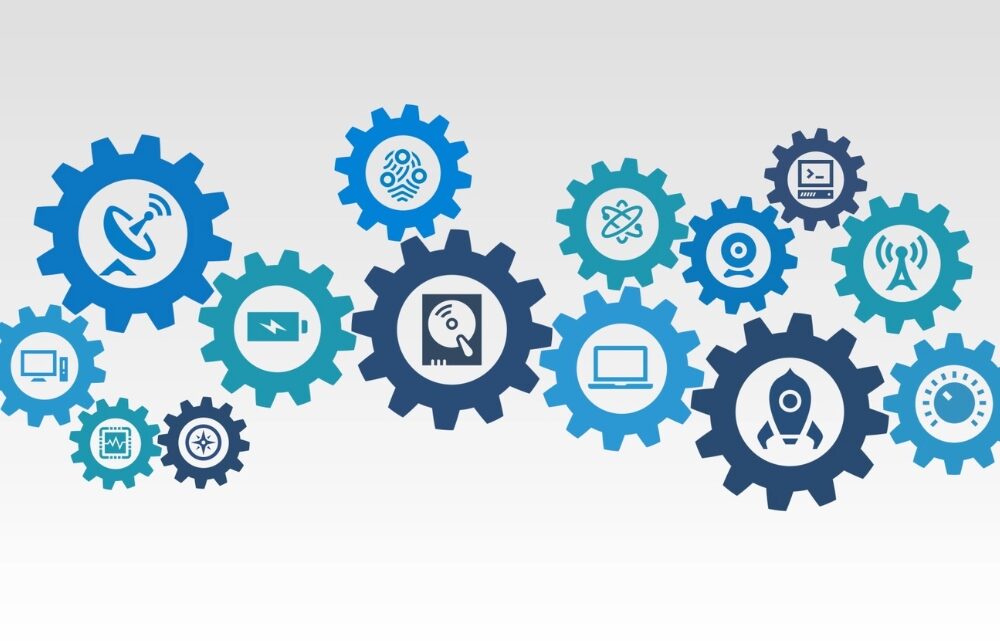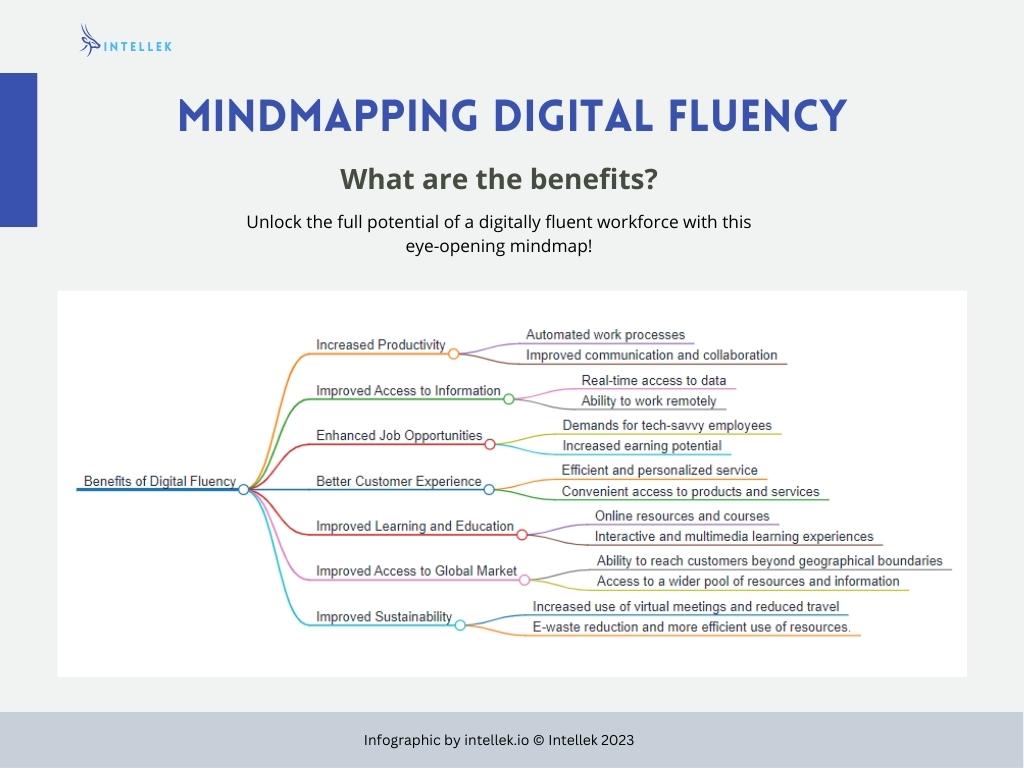
The world of work is undergoing a rapid transformation, with the rise of remote work and the increasing use of automation and artificial intelligence. In this new landscape, digital fluency and adaptability have become essential skills for success.
Digital literacy is a critical component of success in the workplace. From improved productivity to better communication and increased efficiency, having a digitally fluent workforce can provide a competitive advantage for any organization.
But what exactly is digital fluency, and how can employers empower their workforce with these essential skills?
In this article, we will explore the benefits of a digitally fluent workforce, the need for ongoing training and development, the role of leadership, and the future of work in the digital age.
IN THIS ARTICLE...
What is Digital Fluency?
Digital fluency has become an essential skill set in today’s fast-paced work environment. Digital fluency refers to the ability to effectively use digital technologies to communicate, collaborate, and create value in various areas of work. A digitally fluent workforce is critical for companies to stay competitive, as it provides a range of benefits that can drive growth and productivity.
What Are the Key Components of Digital Fluency?
The key components of digital fluency include proficiency in computer and digital device use, knowledge of software and digital tools, an understanding of digital communication and collaboration platforms, and an ability to analyze and make informed decisions using digital data.
This includes having a good understanding of how to use various software and digital platforms, being able to navigate digital tools and systems with ease, and having the ability to communicate and collaborate effectively in a digital environment. Technology is playing an increasingly important role in both personal and professional life, and being digitally fluent is becoming a vital skill for success.
Why is Digital Literacy Important in the Workplace?
In today’s technology-driven world, digital fluency is critical for success in the workplace. It can improve productivity, efficiency, and communication within an organization, and can also help employees stay current with emerging technologies and changing business needs.
Digital literacy is crucial in the modern workplace for several reasons:
- Communication: Most workplace communication is now conducted digitally, through email, instant messaging, video conferencing, and collaboration platforms. Digital literacy enables employees to effectively navigate these tools, understand proper etiquette, and communicate efficiently.
- Information access: The digital world is a vast repository of information, and digital literacy helps employees effectively search, evaluate, and utilize the wealth of resources available online. It allows them to stay updated on industry trends, access relevant research, and make informed decisions.
- Collaboration and teamwork: Many organizations embrace remote work and virtual collaboration tools. Digital literacy helps employees collaborate effectively across different locations and time zones. It allows them to use project management tools, share and edit documents online, and participate in virtual meetings and discussions.
- Problem-solving and critical thinking: Digital literacy empowers employees to leverage technology to solve problems and think critically. It enables them to analyze data, use productivity software, automate tasks, and apply digital tools and resources to find innovative solutions.
- Efficiency and productivity: Digital literacy helps employees leverage technology to streamline workflows, automate repetitive tasks, and increase productivity. It includes skills like file management, using productivity software, mastering keyboard shortcuts, and employing time-saving techniques.
- Adaptability and resilience: With technology rapidly evolving, digital literacy equips employees with the ability to adapt to new tools and platforms. It fosters a mindset of continuous learning, enabling individuals to embrace change, stay agile, and remain competitive in a digital-first workplace.
- Cybersecurity awareness: Digital literacy encompasses knowledge about online safety, privacy, and cybersecurity. In an era of increasing cyber threats, employees need to understand how to protect sensitive data, recognize phishing attempts, use strong passwords, and follow security best practices.
- Digital citizenship: Digital literacy also involves understanding the ethical and responsible use of technology. It includes respecting copyright laws, understanding digital rights and responsibilities, and fostering a positive online presence. These aspects contribute to a positive work culture and reputation.
Digital literacy enhances communication, improves information access, facilitates collaboration, empowers problem-solving, increases efficiency, cultivates adaptability, ensures cybersecurity, and promotes digital citizenship. It is a foundational skill set that empowers employees to thrive in the digital age.
It has become increasingly important for employees to have a certain level of digital competency to be effective in their roles. From the use of digital tools and systems to the ability to navigate new technologies and trends, digital skills have become a necessity for success in the modern workplace.
Why do we need to be Digitally Fluent?
Client expectations and regulatory compliance contribute to the demand for digital fluency. Organizations must be digitally proficient to meet client demands, deliver exceptional customer experiences, comply with regulations, protect client data, and ensure accessibility and inclusivity. Digital literacy plays a vital role in meeting these expectations and staying competitive in today’s digital-centric business environment.
Client Expectation
Clients today expect businesses to be digitally proficient and provide seamless digital experiences. They anticipate efficient communication, online transactions, personalized services, and easy access to information. Digital literacy enables organizations to meet these expectations by effectively utilizing digital tools and platforms, providing a positive user experience, and leveraging data to deliver targeted solutions.
Enhanced Customer Engagement
Digital literacy allows businesses to engage with clients through various digital channels such as social media, websites, and mobile apps. It enables organizations to understand customer needs, preferences, and behavior through data analytics and customer relationship management systems. Digital fluency helps build strong customer relationships, deliver personalized experiences, and provide timely support.
Regulatory Compliance
Many industries have regulations and standards that require organizations to adhere to specific digital practices and data protection measures. For instance, regulations like the General Data Protection Regulation (GDPR) in the European Union or the Health Insurance Portability and Accountability Act (HIPAA) in the healthcare industry have strict requirements for data privacy and security. Digital literacy ensures employees understand and comply with these regulations, minimizing legal and reputational risks.
Data Privacy and Security
As the digital landscape expands, the risk of data breaches and cyber-attacks increases. Clients and consumers are increasingly concerned about the security and privacy of their personal information. Digital literacy helps employees understand the importance of data protection, implement security measures, and follow best practices to safeguard client data. It enables organizations to build trust and demonstrate a commitment to protecting client information.
Accessibility and Inclusivity
Digital fluency includes considerations for accessibility and inclusivity. Organizations must ensure that their digital platform and training content is accessible to individuals with disabilities, adhere to web accessibility guidelines, and provide alternative formats for information. Digital literacy helps employees create inclusive digital experiences and comply with accessibility requirements.
Other Driving Forces
The demand for digital literacy is also driven by several factors in today’s rapidly evolving business landscape:
- Technological advancements: Technology is constantly evolving, and new digital tools and platforms emerge regularly. This creates a demand for digital literacy as individuals need to adapt to and effectively utilize these technologies to remain productive and competitive in their personal and professional lives.
- Digital transformation: Organizations across industries are undergoing digital transformation to improve efficiency, enhance customer experience, and stay ahead of the competition. This transformation requires employees who are digitally literate to adopt and leverage new technologies, systems, and processes.
- Changing nature of work: The nature of work has significantly shifted with the rise of automation, artificial intelligence, and remote work. Digital literacy is essential to navigating these changes, as it enables individuals to work with digital tools, collaborate virtually, and leverage technology to perform tasks more efficiently.
- Global connectivity: The internet has connected people and businesses worldwide, facilitating communication and collaboration across borders. Digital literacy is vital to navigating this interconnected world, effectively communicating with diverse stakeholders, and tapping into global opportunities.
- Information explosion: With the digital revolution, vast amounts of information are now available at our fingertips. Digital literacy is crucial to access, evaluate, and utilize this information effectively. Individuals need to be skilled at searching for information, discerning its quality and relevance, and applying it to solve problems and make informed decisions.
- Economic growth and job market demands: Digital literacy has become a prerequisite for many job roles and industries. Employers increasingly seek candidates with strong digital skills, and individuals with higher levels of digital literacy tend to have better job prospects and earning potential. The demand for digital literacy is driven by the need to meet the evolving job market demands and contribute to economic growth.
- Lifelong learning and personal development: Continuous learning has become a necessity in the digital age. Digital literacy empowers individuals to engage in lifelong learning, acquire new skills, and adapt to changing technologies. It supports personal development, empowers individuals to pursue their passions, and opens doors to new opportunities.
What are the Benefits of Digital Fluency?
From improved communication and collaboration to increased job satisfaction, the benefits of digital fluency are numerous and far-reaching. In this section, we will delve deeper into some of the key advantages that a digitally fluent workforce can bring to an organization.
Harness the Power of Technology
One of the primary benefits of digital fluency is improved productivity. By being able to effectively use digital tools and systems, employees can work more efficiently and effectively, freeing up time and resources to focus on other important tasks.
Digital skills can lead to better communication and collaboration within an organization, as employees are able to use digital tools and platforms to effectively share information and work together on projects.
For example, consider a law firm or accounting company where legal documentation and financial data are critical components of daily operations. In the past, this type of work may have been done manually, with stacks of paper files and manual data entry.
However, with the use of tools like electronic document management systems and cloud-based accounting software, employees can work more efficiently and securely. They can easily access, share, and update important information in real time, reducing the risk of errors and freeing up time to focus on higher-level tasks.
Additionally, the use of secure digital communication platforms allows for more effective collaboration between team members, leading to improved accuracy and faster decision-making. In this way, digital fluency can lead to a more productive and successful work environment for law firms and accounting companies.
Unlock Your Potential
Increased efficiency in the workplace is another key benefit of digital fluency. Whether it’s using digital tools and systems to streamline processes or adopting new technologies that allow for better data analysis and decision-making, digital fluency can help organizations become more efficient and effective.
For example, consider an HR team responsible for onboarding new employees. In the past, this process may have involved a lot of manual paperwork and in-person meetings.
However, with the use of a Digital Adoption Platform (DAP), the HR team can streamline and automate many of the tasks involved in onboarding. From providing new employees with access to company systems and tools to collecting necessary documentation and forms, the HR team can use the DAP to ensure a smooth and efficient onboarding process.
This not only saves time and reduces the risk of errors, but also helps to create a better first impression for new employees, who can get up to speed faster and feel more engaged with the company from the start. In this way, digital competence can lead to increased efficiency and improved outcomes across the organization.
Mindmapping Digital Fluency Benefits
Unlock the full potential of a digitally fluent workforce with this eye-opening mindmap!
Join us in exploring these benefits in more detail through this mindmap, and learn how digital fluency can transform your organization for the better.


Benefits of Digital Fluency in the Workplace
Here is a hierarchical list of the elements that we’ve explored in this mindmap on the benefits of digital fluency in the workplace:
- Increased Productivity
- Automated work processes
- Improved communication and collaboration
- Improved Access to Information
- Real-time access to data
- Ability to work remotely
- Enhanced Job Opportunities
- Demands for tech-savvy employees
- Increased earning potential
- Better Customer Experience
- Efficient and personalized service
- Convenient access to products and services
- Improved Learning and Education
- Online resources and courses
- Interactive and multimedia learning experiences
- Improved Access to Global Market
- Ability to reach customers beyond geographical boundaries
- Access to a wider pool of resources and information
- Improved Sustainability
- Increased use of virtual meetings and reduced travel
- E-waste reduction and more efficient use of resources.
How to Improve Digital Literacy in the Workforce
Employers can promote digital fluency by providing ongoing training and development opportunities, investing in new technologies and tools, and encouraging the adoption of digital best practices throughout the organization.
Additionally, they can offer flexible work arrangements and support a culture of continuous learning and development.
Need for Ongoing Training and Development
It is crucial for employees to continuously develop their digital skills. With new tools and trends emerging regularly, staying up-to-date is essential to maintain digital competence and remaining competitive in the workforce.
However, simply acquiring the necessary skills is not enough – employees must be able to apply them effectively in order to achieve their full potential. This is where ongoing training and development come into play.
In this section, we will explore the importance of staying informed and continuously developing digital skills in the modern workplace.
Stay Ahead of the Curve
As technology continues to evolve, it is essential for employees to stay up-to-date with the latest tools and trends to maintain their digital competence. This means that employers must provide ongoing training and development opportunities for their employees so that they can continue to grow and develop their digital skills.
One of the best ways for an organization to achieve this is through ready-made eLearning that is regularly updated to be sure of accuracy and that the latest information is provided. A subscription-based model for your eLearning will ensure that you are getting all the latest content on any given topic.
Accessible Learning for All
Creating accessible training material is also critical to ensure that all team members have the opportunity to develop their digital fluency. This can include online courses, workshops, and other resources that are designed to be accessible to individuals with disabilities or learning differences.
Additionally, organizations should also consider making training sessions and workshops available remotely, so that employees can participate from the comfort of their own homes.
Digitally Fluent Leaders
The role of leadership is also critical in fostering a culture of ‘digital first’ within an organization. Leaders can provide training and resources, encourage the adoption of new technologies, and set an example of digital literacy themselves.
By doing so, they can help employees feel empowered and motivated to develop their digital skills, creating a culture of continuous learning and growth within the organization.
Protect Your Business
In addition to the technical aspects of digital fluency, it is also important to understand and maintain the security of digital tools and systems, and to protect sensitive data.
Employers should invest in resources and training to ensure that employees understand the importance of security and have the skills they need to maintain a secure digital environment.
This can include training sessions on best practices for data protection and cybersecurity, as well as regular security audits and assessments.
Guard your business against cyber threats with our powerful alliance with KnowBe4 – equipping your employees with the latest cybersecurity training to stay ahead of the game.
How Can Employees Develop Their Digital Skills?
Employees can develop their digital skills by seeking out training and development opportunities, staying current with new technologies and tools, participating in online courses and workshops, and seeking out hands-on experience with digital tools and platforms in their work and personal life.
Future of Work and the Need for Digital Adaptability
Employees must be able to keep up and adjust to new tools and processes to remain relevant and competitive. In this section, we will explore the changing nature of work and the crucial role that digital fluency and adaptability play in the future of employment.
Embracing the Future
The rise of remote work and automation has led to a growing need for digital skills and adaptability in the workplace. With more employees working from home and using digital tools and platforms to communicate and collaborate, digital fluency has become an essential skill for success in the modern workforce.
Additionally, as automation and artificial intelligence become increasingly prevalent, employees must be able to adapt to new technologies and work effectively with these tools to remain competitive.
Empower Your Employees
In order to prepare their employees for the future of work, employers must be proactive in helping them develop the digital skills they need to thrive. This can include providing ongoing training and development opportunities, investing in new technologies and tools, and encouraging the adoption of digital best practices throughout the organization.
Ways to Empower Your Employees:
- Offer regular training and development opportunities on the latest digital tools and trends.
- Encourage the use of digital best practices in daily work processes.
- Provide access to technology resources and support.
- Foster a culture of continuous learning and improvement.
- Offer incentives for employees who show a strong commitment to digital competency.
- Provide opportunities for employees to attend digital conferences and events.
- Invest in digital tools and technologies to streamline processes and improve efficiency.
- Offer mentorship and coaching programs for employees to develop their digital skills.
- Encourage collaboration and knowledge sharing within the organization.
By doing all of this, organizations can create a workforce that is not only digitally fluent but also adaptable and ready for the challenges of the future.
Improving Digital Literacy in the Workplace
As you can see, digital fluency is an essential component of success in the modern workforce. By providing training and resources, encouraging the adoption of new technologies, and fostering a culture of digital literacy and growth, employers can empower their workforce with the digital skills they need to thrive in today’s rapidly changing technological landscape.
So, don’t wait – start bridging the gap to the future of work and empower your employees with digital fluency today!
Intellek (formerly TutorPro) is a founding member of the learning technology industry. With a presence in the USA, UK, Canada, and the EU – for over 30 years we have pioneered the development of cutting-edge eLearning software and online training solutions, with a large and diverse portfolio of international clientele.
Disclaimer: We use all the tools available including generative AI to create relevant and engaging content.





